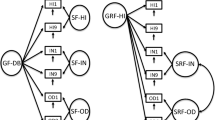Abstract
Halo effects in the assessment of ADHD and ODD were examined. Participants were 159 undergraduate college students who rated children described as showing disruptive behaviors. Bidirectional halo effects were found. Specifically, the presence of oppositionality artificially inflated ratings of inattention and hyperactivity, and the combined presence of inattention and hyperactivity artificially inflated ratings of oppositionality. Several specific items were found to be particularly susceptible to halo effects. Due to these halo effects caution should be exercised when diagnosing multiple behavior disorders, especially with items found to be particularly susceptible. Clinical interviews conducted by mental health professionals may help distinguish between the true presence of multiple disorders and halo effects based on ratings. Future research should determine whether structured interviews conducted by mental health professionals are less susceptible to halo effects than rating scales.

Similar content being viewed by others
References
Abikoff, H., Courtney, M., Pelham, W. E., & Koplewicz, H. S. (1993). Teachers’ ratings of disruptive behaviors: The influence of halo effects. Journal of Abnormal Child Psychology, 21, 519–533.
American Psychiatric Association. (2000). Diagnostic and statistical manual of mental disorders, 4 th edition, Text revision. Washington, DC: Author.
Barkley, R. A. (2006). Attention-deficit/hyperactivity disorder: A handbook for diagnosis and treatment. In R. A. Barkley (Ed.), Comorbid disorders, social and family adjustment, and subtyping (3rd ed.). New York: Guilford.
Barkley, R. A., & Murphy, K. R. (2006). Attention-deficit/hyperactivity disorder: A clinical workbook (3rd ed.). New York: Guilford.
Burns, G. L., Boe, B., Walsh, J. A., Sommers-Flanagan, R., & Teegarden, L. A. (2001). A confirmatory factor analysis on the DSM-IV ADHD and ODD symptoms: What is the best model for the organization of these symptoms? Journal of Abnormal Child Psychology, 29, 339–349.
Conners, C. K. (1969). A teacher rating scale for use in drug studies with children. American Journal of Psychiatry, 126, 884–888.
Hartung, C. M., Van Pelt, J. C., Armendariz, M. L., & Knight, L. A. (2006). Biases in ratings of disruptive behavior in children: Effects of sex and negative halos. Journal of Attention Disorders, 9, 620–630.
Jackson, D. A., & King, A. R. (2004). Gender differences in the effects of oppositional behavior on teacher ratings of ADHD symptoms. Journal of Abnormal Child Psychology, 32, 215–224.
McMahon, R. J., & Frick, P. J. (2005). Evidence-based assessment of conduct problems in children and adolescents. Journal of Clinical Child and Adolescent Psychology, 34, 477–505.
Pelham, W. E., Gnagy, E. M., Greenslade, K. E., & Milich, R. (1992). Teacher ratings of DSM-III-R symptoms for the disruptive behavior disorders. Journal of the American Academy of Child and Adolescent Psychiatry, 31, 210–218.
Pelham, W. E., Fabiano, G. A., & Massetti, G. M. (2005). Evidence-based assessment of attention-deficit hyperactivity disorder in children and adolescents. Journal of Clinical Child and Adolescent Psychology, 34, 449–476.
Schachar, R., Sandberg, S., & Rutter, M. (1986). Agreement between teachers’ ratings and observations of hyperactivity, inattentiveness, and defiance. Journal of Abnormal Child Psychology, 14, 331–345.
Sheskin, D. J. (2007). Handbook of parametric and nonparametric statistical procedures (4th ed.). Boca Raton, FL: Chapman & Hall/CRC.
Stevens, J., Quittner, A. L., & Abikoff, H. (1998). Factors influencing elementary school teachers’ ratings of ADHD and ODD behaviors. Journal of Clinical Child Psychology, 4, 406–414.
Swanson, J. & Carlson, C. L. (1994). DSM-IV rating scale for ADHD and ODD. Unpublished manuscript.
Wolraich, M. L., Lambert, W., Doffing, M. A., Bickman, L., Simmons, T., & Worley, K. (2003). Psychometric properties of the Vanderbilt ADHD diagnostic parent rating scale in a referred population. Journal of Pediatric Psychology, 28, 559–568.
Acknowledgements
We thank the following individuals for their contributions to this project: Chelsea Bauer, Lori Brinlee, John Chaney, Lindsey DeVries, Gay Deitrich-MacLean, Robert Gallen, Sandhya Nambiar, Alan King, MaryBeth McGavran, Kurt Michael, Sara Penning, Jonathan Rule, Douglas Scambler, Brandi Shaw, Katherine Stone, Maureen Sullivan and Ben Wilkowski. In addition, we are grateful to Richard Milich, Christine McKibbin, and several anonymous reviewers for their comments on previous versions of this manuscript.
Author information
Authors and Affiliations
Corresponding author
Rights and permissions
About this article
Cite this article
Hartung, C.M., Lefler, E.K., Tempel, A.B. et al. Halo Effects in Ratings of ADHD and ODD: Identification of Susceptible Symptoms. J Psychopathol Behav Assess 32, 128–137 (2010). https://doi.org/10.1007/s10862-009-9135-3
Published:
Issue Date:
DOI: https://doi.org/10.1007/s10862-009-9135-3



